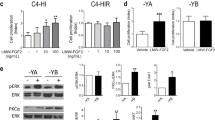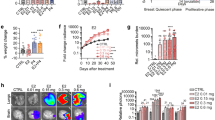Abstract
To explore mechanisms related to hormone resistance, three resistant variants of the MPA mouse breast cancer tumor model with low levels of progesterone receptor (PR) isoform A (PR-A)/high PR-B expression were developed by prolonged selective pressure with antiprogestins. The resistant phenotype of one tumor line was reversed spontaneously after several consecutive passages in syngeneic BALB/c mice or by 17-β-estradiol or tamoxifen treatment, and this reversion was significantly associated with an increase in PR-A expression. The responsive parental tumors disclosed low activation of ERK and high activation of AKT; resistant tumors on the other hand, showed the opposite, and this was associated with a higher metastatic potential, that did not revert. This study shows for the first time in vivo a relationship between PR isoform expression and antiprogestin responsiveness, demonstrating that, whereas acquired resistance may be reversed, changes in kinase activation and metastatic potential are unidirectional associated with tumor progression.








Similar content being viewed by others
References
Santen RJ, Song RX, Zhang Z, Kumar R, Jeng MH, Masamura A et al (2005) Long-term estradiol deprivation in breast cancer cells up-regulates growth factor signaling and enhances estrogen sensitivity. Endocr Relat Cancer 12(Suppl 1):S61–S73. doi:10.1677/erc.1.01018
Osborne CK, Schiff R (2003) Growth factor receptor cross-talk with estrogen receptor as a mechanism for tamoxifen resistance in breast cancer. Breast 12:362–367. doi:10.1016/S0960-9776(03)00137-1
Normanno N, Di Maio M, De Maio E, De Luca A, de Matteis A, Giordano A et al (2005) Mechanisms of endocrine resistance and novel therapeutic strategies in breast cancer. Endocr Relat Cancer 12:721–747. doi:10.1677/erc.1.00857
Haslam SZ (1988) Progesterone effects on deoxyribonucleic acid synthesis in normal mouse mammary glands. Endocrinology 122:464–470
Lydon JP, DeMayo FJ, Funk CR, Mani SK, Hughes AR, Montgomery CA Jr et al (1995) Mice lacking progesterone receptor exhibit pleiotropic reproductive abnormalities. Genes Dev 9:2266–2278. doi:10.1101/gad.9.18.2266
Montero GG, Vanzulli SI, Cerliani JP, Bottino MC, Bolado J, Vela J et al (2007) Association of estrogen receptor alpha and progesterone receptor A expression with hormonal mammary carcinogenesis: role of the host microenvironment. Breast Cancer Res 9:R22. doi:10.1186/bcr1660
Kordon EC, Molinolo AA, Pasqualini CD, Charreau EH, Pazos P, Dran G et al (1993) Progesterone induction of mammary carcinomas in BALB/c female mice. Correlation between progestin dependence and morphology. Breast Cancer Res Treat 28:29–39. doi:10.1007/BF00666353
Moore MR (2004) A rationale for inhibiting progesterone-related pathways to combat breast cancer. Curr Cancer Drug Targets 4:183–189. doi:10.2174/1568009043481515
Lanari C, Molinolo AA, Pasqualini CD (1986) Induction of mammary adenocarcinomas by medroxyprogesterone acetate in BALB/c female mice. Cancer Lett 33:215–223. doi:10.1016/0304-3835(86)90027-3
Lanari C, Molinolo A (2002) Diverse activation pathways for the progesterone receptor: possible implications for breast biology and cancer. Breast Cancer Res 4:240–243. doi:10.1186/bcr539
Aldaz CM, Liao QY, LaBate M, Johnston DA (1996) Medroxyprogesterone acetate accelerates the development and increases the incidence of mouse mammary tumors induced by dimethylbenzanthracene. Carcinogenesis 17:2069–2072. doi:10.1093/carcin/17.9.2069
Women’s Health Initiative (2002) Risks and benefits of estrogen plus progestin in healthy postmenopausal women: principal results From the Women’s Health Initiative randomized controlled trial. JAMA 288:321–333. doi:10.1001/jama.288.3.321
Beral V (2003) Breast cancer and hormone-replacement therapy in the Million Women Study. Lancet 362:419–427. doi:10.1016/S0140-6736(03)14596-5
Kastner P, Krust A, Turcotte B, Stropp U, Tora L, Gronemeyer H et al (1990) Two distinct estrogen-regulated promoters generate transcripts encoding the two functionally different human progesterone receptor forms A and B. EMBO J 9:1603–1614
Leo JC, Lin VC (2008) The activities of progesterone receptor isoform A and B are differentially modulated by their ligands in a gene-selective manner. Int J Cancer 122:230–243. doi:10.1002/ijc.23081
Richer JK, Jacobsen BM, Manning NG, Abel MG, Wolf DM, Horwitz KB (2002) Differential gene regulation by the two progesterone receptor isoforms in human breast cancer cells. J Biol Chem 277:5209–5218. doi:10.1074/jbc.M110090200
Shyamala G, Yang X, Silberstein G, Barcellos-Hoff MH, Dale E (1998) Transgenic mice carrying an imbalance in the native ratio of A to B forms of progesterone receptor exhibit developmental abnormalities in mammary glands. Proc Natl Acad Sci USA 95:696–701. doi:10.1073/pnas.95.2.696
Shyamala G, Yang X, Cardiff RD, Dale E (2000) Impact of progesterone receptor on cell-fate decisions during mammary gland development. Proc Natl Acad Sci USA 97:3044–3049. doi:10.1073/pnas.97.7.3044
Mulac-Jericevic B, Lydon JP, DeMayo FJ, Conneely OM (2003) Defective mammary gland morphogenesis in mice lacking the progesterone receptor B isoform. Proc Natl Acad Sci USA 100:9744–9749. doi:10.1073/pnas.1732707100
Hopp TA, Weiss HL, Hilsenbeck SG, Cui Y, Allred DC, Horwitz KB et al (2004) Breast cancer patients with progesterone receptor PR-A-rich tumors have poorer disease-free survival rates. Clin Cancer Res 10:2751–2760. doi:10.1158/1078-0432.CCR-03-0141
Long BJ, Jelovac D, Handratta V, Thiantanawat A, MacPherson N, Ragaz J et al (2004) Therapeutic strategies using the aromatase inhibitor letrozole and tamoxifen in a breast cancer model. J Natl Cancer Inst 96:456–465
Macedo LF, Sabnis GJ, Goloubeva OG, Brodie A (2008) Combination of anastrozole with fulvestrant in the intratumoral aromatase xenograft model. Cancer Res 68:3516–3522. doi:10.1158/0008-5472.CAN-07-6807
Beeram M, Tan QT, Tekmal RR, Russell D, Middleton A, DeGraffenried LA (2007) Akt-induced endocrine therapy resistance is reversed by inhibition of mTOR signaling. Ann Oncol 18:1323–1328. doi:10.1093/annonc/mdm170
Boylan M, van den Berg HW, Lynch M (1998) The anti-proliferative effect of suramin towards tamoxifen-sensitive and resistant human breast cancer cell lines in relation to expression of receptors for epidermal growth factor and insulin-like growth factor-I: growth stimulation in the presence of tamoxifen. Ann Oncol 9:205–211. doi:10.1023/A:1008241804078
Lin X, Yu Y, Zhao H, Zhang Y, Manela J, Tonetti DA (2006) Overexpression of PKCalpha is required to impart estradiol inhibition and tamoxifen-resistance in a T47D human breast cancer tumor model. Carcinogenesis 27:1538–1546. doi:10.1093/carcin/bgl002
Naundorf H, Fichtner I, Saul GJ, Haensch W, Buttner B (1993) Establishment and characteristics of two new human mammary carcinoma lines serially transplantable in nude mice. J Cancer Res Clin Oncol 119:652–656. doi:10.1007/BF01215983
Molinolo AA, Lanari C, Charreau EH, Sanjuan N, Pasqualini CD (1987) Mouse mammary tumors induced by medroxyprogesterone acetate: immunohistochemistry and hormonal receptors. J Natl Cancer Inst 79:1341–1350
Vanzulli SI, Soldati R, Meiss R, Colombo L, Molinolo AA, Lanari C (2005) Estrogen or antiprogestin treatment induces complete regression of pulmonary and axillary metastases in an experimental model of breast cancer progression. Carcinogenesis 26:1055–1063. doi:10.1093/carcin/bgi060
Simian M, Molinolo A, Lanari C (2006) Involvement of matrix metalloproteinase activity in hormone-induced mammary tumor regression. Am J Pathol 168:270–279. doi:10.2353/ajpath.2006.050012
Fabris VT, Benavides F, Conti C, Merani S, Lanari C (2005) Cytogenetic findings, Trp53 mutations, and hormone responsiveness in a medroxyprogesterone acetate induced murine breast cancer model. Cancer Genet Cytogenet 161:130–139. doi:10.1016/j.cancergencyto.2005.02.008
Institute of Laboratory Animal Resources CoLSNRC (1996) Guide for the care and use of laboratory animals. National Academy Press, Washington, DC
Kordon EC, Guerra F, Molinolo AA, Charreau EH, Pasqualini CD, Pazos P et al (1994) Effect of sialoadenectomy on medroxyprogesterone-acetate-induced mammary carcinogenesis in BALB/c mice. Correlation between histology and epidermal-growth-factor receptor content. Int J Cancer 59:196–203. doi:10.1002/ijc.2910590210
Helguero LA, Viegas M, Asaithamby A, Shyamala G, Lanari C, Molinolo AA (2003) Progesterone receptor expression in medroxyprogesterone acetate-induced murine mammary carcinomas and response to endocrine treatment. Breast Cancer Res Treat 79:379–390. doi:10.1023/A:1024029826248
Vanzulli S, Efeyan A, Benavides F, Helguero L, Peters G, Shen J et al (2002) p21, p27 and p53 in estrogen and antiprogestin-induced tumor regression of experimental mouse mammary ductal carcinomas. Carcinogenesis 23:749–757. doi:10.1093/carcin/23.5.749
Liu W, Bagaitkar J, Watabe K (2007) Roles of AKT signal in breast cancer. Front Biosci 12:4011–4019. doi:10.2741/2367
Montecchia MF, Lamb C, Molinolo AA, Luthy IA, Pazos P, Charreau E et al (1999) Progesterone receptor involvement in independent tumor growth in MPA-induced murine mammary adenocarcinomas. J Steroid Biochem Mol Biol 68:11–21. doi:10.1016/S0960-0760(98)00166-6
Aupperlee MD, Smith KT, Kariagina A, Haslam SZ (2005) Progesterone receptor isoforms A and B: temporal and spatial differences in expression during murine mammary gland development. Endocrinology 146:3577–3588. doi:10.1210/en.2005-0346
Horwitz KB, Tung L, Takimoto GS (1996) Novel mechanisms of antiprogestin action. Acta Oncol 35:129–140. doi:10.3109/02841869609098493
Lamb CA, Helguero LA, Giulianelli S, Soldati R, Vanzulli SI, Molinolo A et al (2005) Antisense oligonucleotides targeting the progesterone receptor inhibit hormone-independent breast cancer growth in mice. Breast Cancer Res 7:R1111–R1121. doi:10.1186/bcr1345
Dran G, Luthy IA, Molinolo AA, Charreau EH, Pasqualini CD, Lanari C (1995) Effect of medroxyprogesterone acetate (MPA) and serum factors on cell proliferation in primary cultures of an MPA-induced mammary adenocarcinoma. Breast Cancer Res Treat 35:173–186. doi:10.1007/BF00668207
Arruvito L, Giulianelli S, Flores AC, Paladino N, Barboza M, Lanari C et al (2008) NK cells expressing a progesterone receptor are susceptible to progesterone-induced apoptosis. J Immunol 180:5746–5753
Ingle JN, Ahmann DL, Green SJ, Edmonson JH, Bisel HF, Kvols LK et al (1981) Randomized clinical trial of diethylstilbestrol versus tamoxifen in postmenopausal women with advanced breast cancer. N Engl J Med 304:16–21
Carter AC, Sedransk N, Kelley RM, Ansfield FJ, Ravdin RG, Talley RW, Potter NR (1977) Diethylstilbestrol recommended dosages for different categories of breast cancer patients. Report of the Cooperative Breast Cancer Group. JAMA 237:2079–2085
Beex L, Pieters G, Smals A, Koenders A, Benraad T, Kloppenborg P (1981) Tamoxifen versus ethinyl estradiol in the treatment of postmenopausal women with advanced breast cancer. Cancer Treat Rep 65:179–185
Lonning PE, Taylor PD, Anker G, Iddon J, Wie L, Jorgensen LM et al (2001) High-dose estrogen treatment in postmenopausal breast cancer patients heavily exposed to endocrine therapy. Breast Cancer Res Treat 67:111–116. doi:10.1023/A:1010619225209
Conneely OM, Jericevic BM, Lydon JP (2003) Progesterone receptors in mammary gland development and tumorigenesis. J Mammary Gland Biol Neoplasia 8:205–214. doi:10.1023/A:1025952924864
Weigel RJ, deConinck EC (1993) Transcriptional control of estrogen receptor in estrogen receptor-negative breast carcinoma. Cancer Res 53:3472–3474
Ferguson AT, Lapidus RG, Davidson NE (1998) Demethylation of the progesterone receptor CpG island is not required for progesterone receptor gene expression. Oncogene 17:577–583. doi:10.1038/sj.onc.1201961
Martin LA, Farmer I, Johnston SR, Ali S, Dowsett M (2005) Elevated ERK1/ERK2/estrogen receptor cross-talk enhances estrogen-mediated signaling during long-term estrogen deprivation. Endocr Relat Cancer 12(Suppl 1):S75–S84. doi:10.1677/erc.1.01023
Brodie A, Sabnis G, Jelovac D (2006) Aromatase and breast cancer. J Steroid Biochem Mol Biol 102:97–102. doi:10.1016/j.jsbmb.2006.09.002
Qiu M, Olsen A, Faivre E, Horwitz KB, Lange CA (2003) Mitogen activated protein kinase regulates nuclear association of human progesterone receptors. Mol Endocrinol 17:628–642. doi:10.1210/me.2002-0378
Labriola L, Salatino M, Proietti CJ, Pecci A, Coso OA, Kornblihtt AR et al (2003) Heregulin induces transcriptional activation of the progesterone receptor by a mechanism that requires functional ErbB-2 and mitogen-activated protein kinase activation in breast cancer cells. Mol Cell Biol 23:1095–1111. doi:10.1128/MCB.23.3.1095-1111.2003
Faivre EJ, Daniel AR, Hillard CJ, Lange CA (2008) Progesterone receptor rapid signaling mediates serine 345 phosphorylation and tethering to specificity protein 1 transcription factors. Mol Endocrinol 22:823–837. doi:10.1210/me.2007-0437
Tokunaga E, Kimura Y, Mashino K, Oki E, Kataoka A, Ohno S et al (2006) Activation of PI3K/Akt signaling and hormone resistance in breast cancer. Breast Cancer 13:137–144. doi:10.2325/jbcs.13.137
Toker A, Yoeli-Lerner M (2006) Akt signaling and cancer: surviving but not moving on. Cancer Res 66:3963–3966. doi:10.1158/0008-5472.CAN-06-0743
Acknowledgements
We are grateful P. Do Campo for excellent technical assistance and to Laboratorios Gador, Buenos Aires for kindly providing MPA (Medrosterona) and TAM, and to Bayer Schering Pharma AG, Berlin for the ZK 230211. We also wish to thank Avon Foundation and AFLAC for AACR travel awards to V. Wargon. The authors declare that they have no competing interests.
Financial support
Sales Foundation, SECyT (PICT 03-14406 and PICT 05-15038) and CONICET (PIP 5351).
Author information
Authors and Affiliations
Corresponding author
Rights and permissions
About this article
Cite this article
Wargon, V., Helguero, L.A., Bolado, J. et al. Reversal of antiprogestin resistance and progesterone receptor isoform ratio in acquired resistant mammary carcinomas. Breast Cancer Res Treat 116, 449–460 (2009). https://doi.org/10.1007/s10549-008-0150-y
Received:
Accepted:
Published:
Issue Date:
DOI: https://doi.org/10.1007/s10549-008-0150-y




